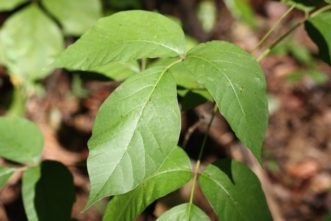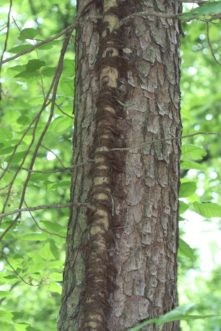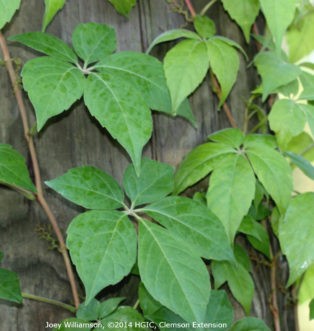Poison ivy, with its infamous “leaves of three,” is a common nuisance for homeowners, gardeners, and outdoor enthusiasts. Eastern poison ivy (Toxicodendron radicans) is a pervasive plant that can thrive in various environments, from woodlands to home landscapes, and is notorious for causing an itchy, uncomfortable rash upon contact. This rash is triggered by urushiol, an oil found throughout the plant, making even dead poison ivy a potential hazard. Therefore, understanding how to effectively kill and remove poison ivy is crucial for protecting yourself, your family, and your property. This guide provides comprehensive methods for poison ivy eradication, ensuring a safer and more comfortable outdoor experience.
Identifying Poison Ivy: Know Your Enemy
Before you can effectively kill poison ivy, accurate identification is essential. Mistaking beneficial plants for poison ivy can lead to unnecessary removal, while failing to recognize poison ivy can result in painful skin reactions. Key characteristics of poison ivy include:
Leaves of Three: “Leaflets Three, Let it Be”
The most recognizable feature of poison ivy is its trifoliate leaves, meaning each leaf is composed of three leaflets. These leaflets can vary in appearance, with edges that may be smooth, wavy, lobed, or toothed. Some leaflets may even resemble oak leaves. The leaves are typically green in spring and summer, turning vibrant shades of red and orange in the fall.
Eastern poison ivy with smooth leaf margins, showcasing the plant’s characteristic three-leaflet structure.
Growth Habits: Vine or Shrub
Poison ivy can grow as both a woody vine and a small shrub. As a vine, it climbs trees and other structures using hairy aerial roots that emerge from the stem. This “hairy vine” appearance is another identifying characteristic. It can also grow as a groundcover or low-lying shrub, particularly in open areas.
Poison ivy vine with hairy aerial roots, illustrating how the vine attaches to surfaces as it climbs.
White Berries: Fruit of Poison Ivy
Mature poison ivy plants produce clusters of small, white to off-white, waxy berries. These berries are spread by birds and other wildlife, contributing to the plant’s dispersal. While these berries may look innocuous, all parts of the poison ivy plant, including the berries, contain urushiol and are poisonous.
White berries of poison ivy, highlighting the mature plant’s fruit which aids in seed dispersal by birds.
Distinguishing from Virginia Creeper
It’s easy to confuse poison ivy with Virginia creeper (Parthenocissus quinquefolia), as both can grow as vines. However, Virginia creeper has compound leaves with five leaflets, not three. Remembering “leaves of five, let it thrive” can help you differentiate between the two. Virginia creeper is harmless and even provides beautiful fall color.
Virginia creeper showing its distinctive five leaflets, differentiating it from poison ivy’s three leaflets.
Why Kill Poison Ivy? Understanding the Risks
The primary reason to kill poison ivy is to eliminate the risk of urushiol exposure and the resulting allergic reaction. Urushiol is a potent skin irritant found in all parts of the poison ivy plant – leaves, stems, roots, and berries.
Urushiol and Allergic Reactions
Urushiol oil causes contact dermatitis, a type of eczema, in sensitive individuals. Upon contact, urushiol quickly penetrates the skin. Reactions can range from mild itching and redness to severe rashes with blisters, swelling, and intense discomfort. The severity of the reaction varies among individuals, with some people being highly sensitive, while others are less reactive. However, sensitivity can develop over time, meaning even those who were previously unaffected can become allergic.
Health Concerns and Exposure Pathways
Exposure to urushiol can occur through direct contact with the plant, indirect contact with contaminated objects (tools, clothing, pet fur), or even airborne contact through smoke from burning poison ivy. Inhaling smoke containing urushiol can cause serious respiratory irritation and systemic reactions in highly sensitive individuals. The oil can remain active on surfaces for months, making thorough cleaning of potentially contaminated items essential.
Preventing Spread and Protecting Your Property
Poison ivy spreads through underground rhizomes and seeds, allowing it to quickly colonize areas. Birds and animals readily consume the berries and disperse seeds widely. Controlling poison ivy prevents its encroachment into gardens, lawns, and play areas, reducing the likelihood of accidental contact and protecting your property’s aesthetic and usability.
Effective Methods to Kill Poison Ivy
Killing poison ivy requires persistence and the right approach. Both manual and chemical methods can be effective, depending on the infestation size and location.
Manual Removal: Digging and Cutting
For small infestations or areas where herbicides are not desired, manual removal is a viable option.
Digging
Digging out poison ivy plants, including the roots, can be effective, especially for young plants or small patches. This method is labor-intensive but avoids the use of chemicals. To dig out poison ivy:
- Protective Gear: Wear long sleeves, long pants, gloves, and eye protection to prevent skin contact with urushiol.
- Loosen Soil: Use a shovel or trowel to loosen the soil around the poison ivy plant.
- Carefully Remove Roots: Gently pull the plant, trying to remove as much of the root system as possible. Poison ivy spreads through rhizomes, so removing the roots is crucial to prevent regrowth.
- Dispose Properly: Place the removed plants in plastic bags and dispose of them in the trash. Do not compost or burn poison ivy, as urushiol can persist in compost and become airborne in smoke.
- Clean Tools and Gloves: Thoroughly wash tools and gloves that have come into contact with poison ivy with soap and water to remove any urushiol oil.
Cutting Back
Repeatedly cutting back poison ivy to ground level can weaken and eventually kill the plant over time. This method starves the plant by preventing it from photosynthesizing and replenishing its root reserves.
- Timing: Start cutting in early spring when new leaves emerge.
- Frequency: Cut back new growth every week or two whenever you see it reappear.
- Persistence: Consistent cutting over several months or even a year may be necessary to fully eradicate poison ivy using this method.
- Safety: Always wear protective clothing when cutting poison ivy to avoid skin contact.
Chemical Control: Herbicides for Poison Ivy
For larger infestations or situations where manual removal is impractical, herbicides can provide a more efficient way to kill poison ivy. Several types of herbicides are effective against poison ivy, including those containing glyphosate, triclopyr, and combinations of 2,4-D, dicamba, and mecoprop.
Best Herbicides and Application
- Glyphosate: Glyphosate-based herbicides are non-selective, meaning they will kill any plant they contact. Use them carefully to target poison ivy and avoid spraying desirable plants. Glyphosate is most effective when applied to actively growing foliage.
- Triclopyr: Triclopyr is a selective herbicide that targets broadleaf plants like poison ivy while being less harmful to grasses. It is effective on woody plants and vines, making it a good choice for mature poison ivy.
- 2,4-D, Dicamba, and Mecoprop (Combination Herbicides): These herbicides are often found in “3-way” lawn weed killers and are effective against broadleaf weeds, including poison ivy, in lawns. They are selective for lawns but should be used according to label directions to avoid damaging desired grasses.
Application Methods:
- Foliar Spray: Spraying the herbicide directly onto the leaves of poison ivy is effective for actively growing plants. Follow label instructions for dilution rates and application techniques.
- Cut-Stem Treatment: For poison ivy growing among desirable plants, cut the poison ivy stems at the base and apply herbicide directly to the freshly cut stump. This minimizes herbicide contact with non-target plants. You can paint the herbicide onto the cut stump for precise application.
Table 1. Examples of Post-emergence Spray Herbicides for Control of Poison Ivy.
| Brands & Specific Products | Post-emergence Herbicide Active Ingredient | % Active Ingredient in Product | Labeled for Use on Listed Turfgrass Species |
|---|---|---|---|
| Ortho GroundClear Poison Ivy & Tough Brush Killer Concentrate; & RTU2 | Triclopyr | 8.0 | None |
| Ferti-lome Brush Killer Stump Killer Concentrate Southern AG Brush Killer Monterey Brush & Vine Killer Concentrate | Triclopyr | 8.8 | None |
| Ortho Weed B Gon Chickweed, Clover & Oxalis Killer for Lawns Concentrate; & RTS1 | Triclopyr | 8.0 | Tall Fescue Zoysiagrass |
| Hi-Yield Triclopyr Ester Herbicide Concentrate Monterey Turflon Ester | Triclopyr | 61.6 | Tall Fescue |
| Bayer BioAdvanced Southern Weed Killer for Lawns Concentrate; & RTS1 | 2,4-D Mecoprop Dicamba | 7.59 1.83 0.84 | Tall Fescue Bermudagrass Zoysiagrass St. Augustinegrass(use at lower label rate) Centipedegrass (use at lower labelrate) |
| Ferti-lome Weed-Out Lawn Weed Killer Concentrate | 2,4-D Mecoprop Dicamba | 5.88 5.45 1.21 | |
| Southern Ag Lawn Weed Killer with Trimec Concentrate | 2,4-D Mecoprop Dicamba | 3.05 5.30 1.29 | |
| Spectracide Weed Stop for Lawns Concentrate; & RTS1 | 2,4-D Mecoprop Dicamba Sulfentrazone | 7.57 2.73 0.71 0.18 | |
| Roundup Original Concentrate, Roundup Pro Herbicide, Martin’s Eraser Systemic Weed & Grass Killer, Bonide Kleenup 41% Weed & Grass Killer Concentrate Hi-Yield Super Concentrate Killzall Weed & Grass Killer Maxide Super Concentrate 41% Weed & Grass Killer Zep Enforcer Weed Defeat Eliminator Weed & Grass Killer Super Concentrate Monterey Remuda Full Strength 41% Glyphosate Knock Out Weed & Grass Killer Super Concentrate Agrisel Ply Pho-Sel Pro 41% | Glyphosate | 41 – 50% | None |
| 1RTS: Ready-to-Spray (hose-end sprayer) 2RTU: Ready-to-Use (pre-mixed spray bottle for spot spraying) |




Herbicide Safety and Precautions
- Read the Label: Always read and carefully follow all label directions on herbicide products. Pay attention to safety precautions, application rates, and target plants.
- Protect Desirable Plants: Shield or cover nearby desirable plants when spraying herbicides to prevent accidental damage.
- Weather Conditions: Apply herbicides on calm days to avoid drift to non-target areas. Avoid application before rain, as it may wash away the herbicide.
- Timing: Herbicides are generally most effective when applied to actively growing plants. Refer to the product label for specific timing recommendations. For poison ivy, late spring to early summer when plants are actively growing is often ideal. Triclopyr can be effective later into the season, before fall color change. Glyphosate works well when applied around bloom time.
- Repeated Applications: Poison ivy can be persistent, and repeated herbicide applications may be necessary for complete eradication, especially for mature plants with extensive root systems.
- Pollinator Safety: Be mindful of pollinating insects. Avoid spraying herbicides when pollinators are active, or spray in the late evening to minimize impact. Consider less toxic alternatives when possible.
Prevention and Long-term Control
Once you have killed poison ivy, preventing its return is important.
- Monitor Regularly: Regularly inspect your property for new poison ivy seedlings or regrowth from roots.
- Prompt Removal: Remove any new poison ivy plants as soon as you spot them to prevent them from establishing and spreading.
- Encourage Desirable Vegetation: Promote the growth of dense, desirable vegetation in areas prone to poison ivy. Competition from other plants can help suppress poison ivy growth.
- Birdseed Management: If birds are spreading poison ivy seeds, consider managing bird feeders or cleaning up spilled birdseed, which can attract seed-dispersing birds.
Safety Precautions When Handling Poison Ivy
Regardless of the method you choose to kill poison ivy, safety should be your top priority to avoid urushiol exposure.
Protective Gear is Essential
Always wear protective clothing when working around poison ivy, whether you are manually removing it or applying herbicides.
- Gloves: Use impermeable gloves, such as vinyl or nitrile gloves. Cloth or latex gloves may not provide adequate protection.
- Long Sleeves and Pants: Wear long sleeves and pants to cover exposed skin. Tuck pants into socks or boots to prevent gaps.
- Eye Protection: Wear safety glasses or goggles to protect your eyes from urushiol and herbicide spray.
- Respirator (for burning): Avoid burning poison ivy if possible. If burning is unavoidable in controlled situations, wear a respirator to avoid inhaling urushiol-containing smoke.
Washing After Exposure: Act Quickly
If you suspect you have come into contact with poison ivy, prompt washing is crucial to minimize the risk of a rash.
- Within 10-30 Minutes: Wash the exposed skin area thoroughly with cool running water and soap as soon as possible, ideally within 10 to 30 minutes of contact. Avoid using soaps containing oils, as these can spread urushiol.
- Specialized Cleansers: Consider using specialized poison ivy cleansers like Tecnu or Zanfel, which are designed to remove urushiol oil from the skin. Rubbing alcohol can also help dissolve urushiol.
- Wash Clothing and Gear: Wash clothing and gear that may have come into contact with poison ivy separately from other laundry using hot water and detergent. Urushiol can remain on clothing and cause repeated exposure.
Conclusion: Eradicating Poison Ivy for a Safer Environment
Killing poison ivy is an important step in creating a safe and enjoyable outdoor environment. By accurately identifying poison ivy and employing appropriate removal methods, whether manual digging and cutting or targeted herbicide application, you can effectively manage and eliminate this nuisance plant. Always prioritize safety by wearing protective gear and washing thoroughly after potential exposure to prevent allergic reactions. With persistence and the right strategies, you can successfully control poison ivy and reclaim your yard and garden.